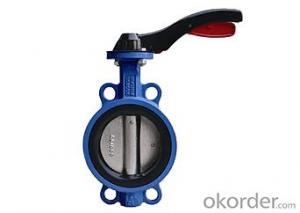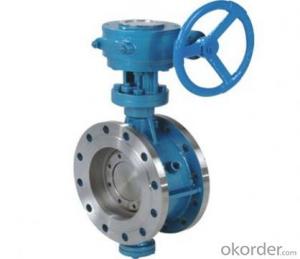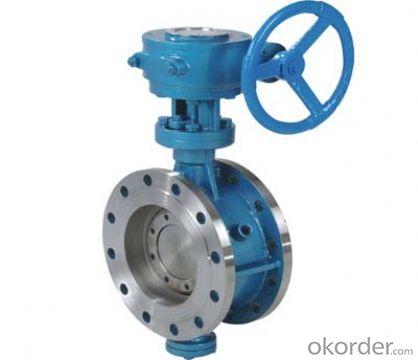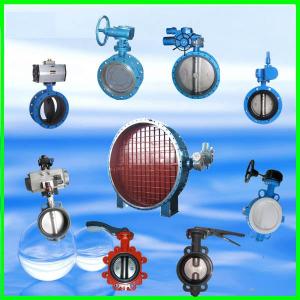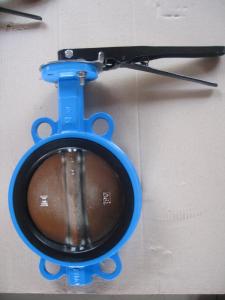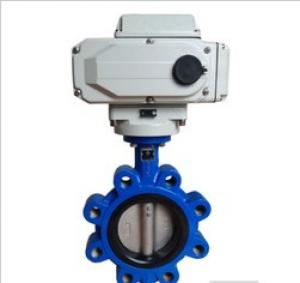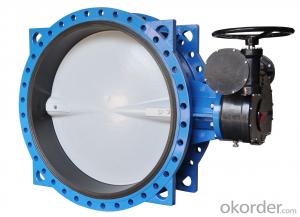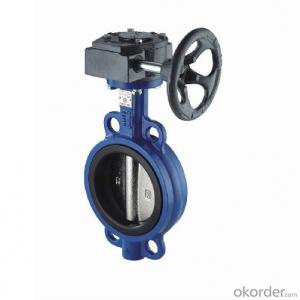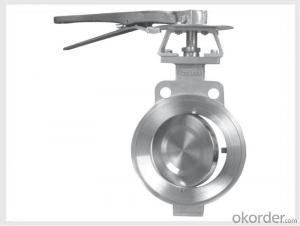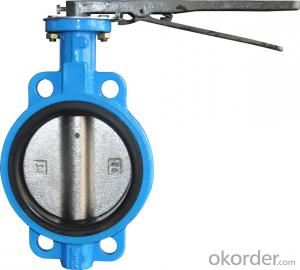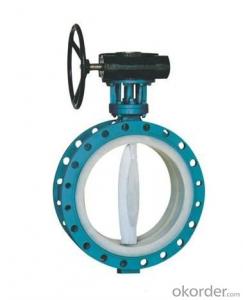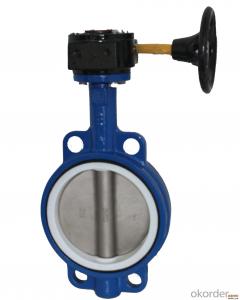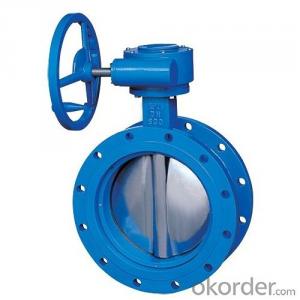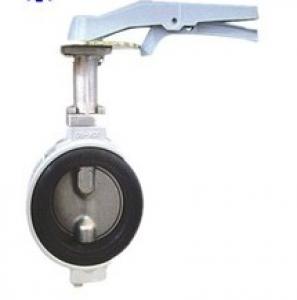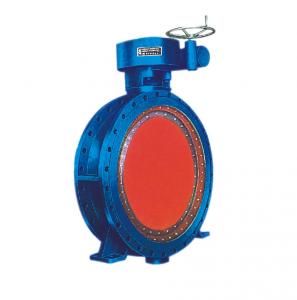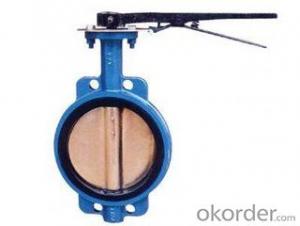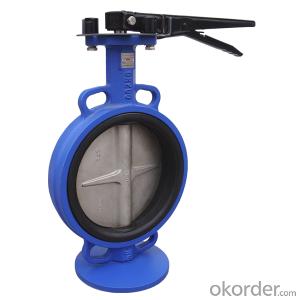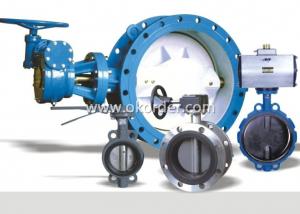Butterfly Valves Ductile Iron Wafer Type DN530
- Loading Port:
- China main port
- Payment Terms:
- TT OR LC
- Min Order Qty:
- 200 set
- Supply Capability:
- 80000 set/month
OKorder Service Pledge
OKorder Financial Service
You Might Also Like
1. Manual Wafer Butterfly Valve Description:
A butterfly valve is a valve which can be used for isolating or regulating flow. The closing mechanism takes the form of a disk. Operation is similar to that of a ball valve, which allows for quick shut off. Butterfly valves are generally favored because they are lower in cost to other valve designs as well as being lighter in weight, meaning less support is required. Unlike a ball valve, the disc is always present within the flow, therefore a pressure drop is always induced in the flow, regardless of valve position.
2.Main Features of the Manual Wafer Butterfly Valve
Design & Manufacture acc. to API 609,MSS SP-67,BS5155,BS EN593.
Face to Face acc. to DIN3202,API609,MSS SP-67,BS5155,BS EN558.
Top Flange acc. to ISO5211.
Pressure test acc. to API598,BS EN12266-1,DIN3230,BS5155.
Side Flange acc. to DIN2501,ANSI125/150,AS2129,BS4504,BS10D&E,JIS10K
A butterfly valve consists of body ,stem ,disc , actuator (manual actuator, worm-gear actuator , aerodynamic actuator or electric actuator) , and wafer type butterfly valve can implement the process for turning on turning off and regulating the flow by the circumrotation of stem and disc that is droved by actuators.
3. Manual Wafer Butterfly Valve Images:
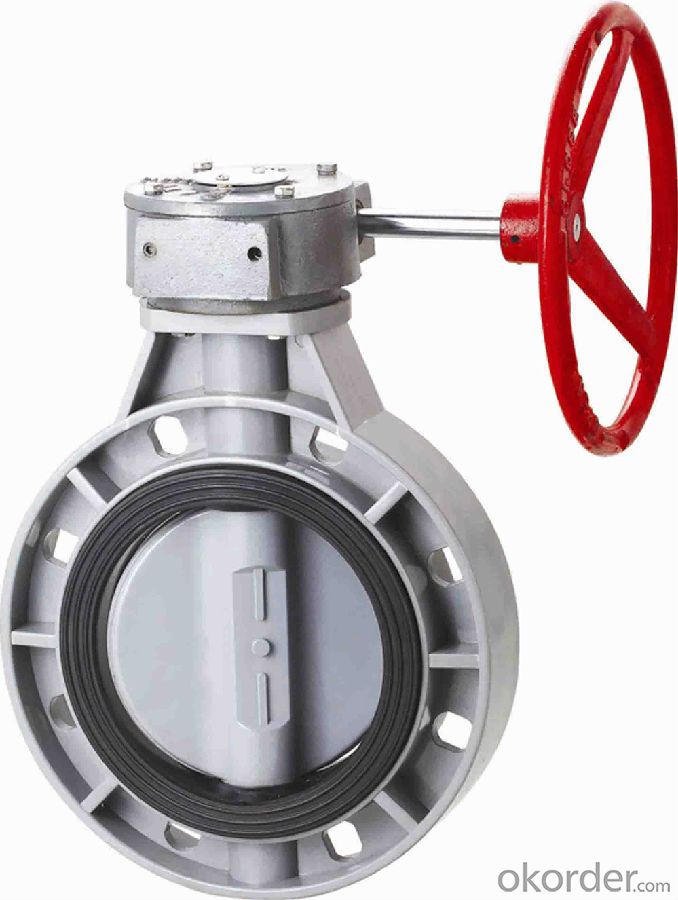
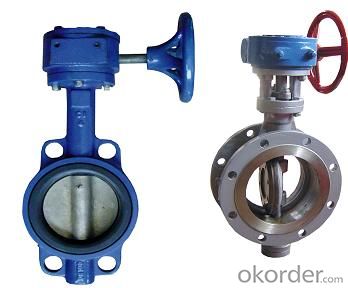
4.Manual Wafer Butterfly Valve Specification:
Size: | DN50-DN1000 |
End flange: | ANSI B 16.1,EN1092,AS2129 |
Face to face: | ANSI B 16.10 |
Top flange: | ISO 5211 |
Normal pressure: | PN1.0/1.6MPa(150/200PSI) |
Body: | CI/DI/WCB/ALB/CF8/CF8M |
Disc: | DI/ALB/Rubber lined Disc/1.2501/1.4529/CF8/Hastelloy Alloy/Monel |
Stem: | 410/416/304/431/17-4PH/316/monel |
Seat: | NBR/Hypalon/EPDM/Neoprene/NR/Wear-Resistant EPDM/Viton/Silicon/Heat-Resistant EPDM/White EPDM/EPDM(NSF)/PTFE |
Suitable temperature: | -10~120 |
Medium: | Fresh water, sewage, sea water, air, vapor, food, medicine, oils, alkalis, salt etc. |
5.FAQ
1. What is manual wafer butterfly valve?
A: Wafer style is the more common of the two and is less expensive than the lug style. The wafer style butterfly valve is just about the standard. It ís so common that no one even bothers to use the word "wafer" when ordering a butterfly valve. It is taken for granted that if a butterfly valve is ordered, a wafer style will be received.
2. How about the Installation of the Wafer Style Butterfly Valve?
A: Butterfly valves are installed by inserting the valve between two flanges using bolts or studs and nuts to hold it all together. This type of installation, of course, makes it impossible to disconnect just one side of the piping system from the valve. That benefit is received using the lug style valve.
3. What is the working principle of manual wafer butterfly valve?
A: A butterfly valve is from a family of valves called quarter-turn valves. In operation, the valve is fully open or closed when the disc is rotated a quarter turn. The "butterfly" is a metal disc mounted on a rod. When the valve is closed, the disc is turned so that it completely blocks off the passageway. When the valve is fully open, the disc is rotated a quarter turn so that it allows an almost unrestricted passage of the fluid. The valve may also be opened incrementally to throttle flow.
- Q: How many kinds of butterfly valves are there?
- What's the score?There are central butterfly valve, double eccentric butterfly valve, three eccentric butterfly valveAnd according to the materialAnd according to the way of connection
- Q: How much is the Honeywell butterfly DN300?
- Find the agent or find a reliable valve plant a lot of foreign brands are in Chinese OEM so find a reliable factory is relatively good service to keep up
- Q: Okay, so I've been thinking about trying to learn how to play my dad's baritone bugle, but I have no idea how to. If anyone had a good fingering chart for it, that would be great. The bugle has one valve and a trigger. I am a natural flute player and percussionist, so this is my first time playing a brass instrument. Needless to say I am very confused. Call me a noob, I don't care, as long as you get me a fingering chart for a 1 valve baritone bugle. Please help. :)
- This Site Might Help You. RE: 1 valve bugle fingering chart? (more complicated than it sounds)? Okay, so I've been thinking about trying to learn how to play my dad's baritone bugle, but I have no idea how to. If anyone had a good fingering chart for it, that would be great. The bugle has one valve and a trigger. I am a natural flute player and percussionist, so this is my first time...
- Q: Butterfly valve flow direction is single or two-way?
- The arrow on the butterfly valve is the medium direction of circulation, generally double eccentric, and the three eccentric butterfly valve has the arrow in this direction.The butterfly valve, the valve direction and fluid flow direction should be consistent, we use the butterfly valve is in accordance with the arrow direction and flow direction of the installation.If the arrow is marked on the valve body, it must be installed in its direction. If it is marked on the handle, it means open. Depending on the internal structure, it is possible to have the installation direction required.
- Q: What are the classification criteria for pneumatic butterfly valves?
- The channel of the valve body inner surface smooth, fluid resistance, high CV value, strong circulation, moderate torque, the use of four seal structure and elastic rubber gasket seat with SI in high temperature aging on the outside sealing surface, zero leakage medium.Pneumatic butterfly, characteristics, there is a slit leaving the valve seat, the product is suitable for use in poor air circulation environment.The pneumatic telescopic butterfly valve is characterized in that the novel and reasonable design, unique structure, light weight, convenient operation, open and close rapidly; in addition to the telescopic valve for regulating and throttling effect, compensation pipeline temperature generated by thermal expansion and contraction function, but also for the installation of valve replacement and maintenance convenience. The sealing parts can be adjusted, replaced, sealed, reliable and so on.
- Q: How is the lug butterfly valve connected to the flange?
- It is clip type butterfly valve.Connection way is to use butterfly flange flange.The sealing surfaces at the ends of the two rubber sealing rings are respectively butted with the welded flanges welded on the pipe; the two headed screws and the nuts are used for fastening.
- Q: i was changing valve seals and two dropped i can see the head of the valve but a magnet wont pull them up i put air the spark plug hole too but no luck 1985 ford bronco II
- Your going to have to pull the heads.
- Q: Butterfly valve network and ordinary butterfly what is the difference?
- Pipeline butterfly valve is turntable upward, like the gate valve, can be installed in the ground, the ordinary turntable is left or right.
- Q: D what's the meaning of "one 71x one 1 butterfly"?
- According to the provisions of the JB/T 308-2004 valve type programming method:D== butterfly valve7== clip typeLinetype in 1==X== sealing surface material: Rubber-1== pressure rating: 1.0MPa
- Q: I have a good set of #142 Pontiac heads with small diameter valves. I want to have the heads enlarged to accept the larger Pontiac valves, and I have the larger exhaust valves out of #13 heads and the larger intakes from 6X8 heads. The valves appear ok and shiny on the stems
- Roll the valves by the stems on a perfectly flat table. If there is no wobble, your valves are most likely not bent. Take them to a machine shop and have them checked for imperfections and reground and they'll be good as new.
Send your message to us
Butterfly Valves Ductile Iron Wafer Type DN530
- Loading Port:
- China main port
- Payment Terms:
- TT OR LC
- Min Order Qty:
- 200 set
- Supply Capability:
- 80000 set/month
OKorder Service Pledge
OKorder Financial Service
Similar products
Hot products
Hot Searches
Related keywords
